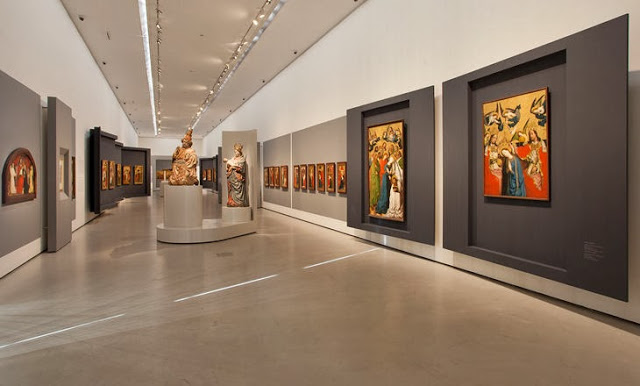Medieval History
- Masterpieces From The Christian Museum On View In St. Pölten
The Christian Museum of Esztergom is the largest ecclesiastical collection in Hungary, conserving European and Hungarian works of art from several centuries. Opened for the public in 1875, it became the third most significant picture gallery in Hungary,...
- News From Hungarian Museums
Medieval and Renaissance tapestries on view at Esztergom Calvary Tournai, late 15th century Esztergom, Christian Museum An exhibition of tapestries has been on view at the Christian Museum in Esztergom since May. The Museum holds a significant...
- Medieval News From The End Of 2013
There were quite a lot of things I wanted to report on at the end of 2013. I hope to come back to these subject individually in the near future - for now, I can only give a brief listing of these news. Medieval palace chapel reopened at Esztergom After...
- Collection Databases Of Hungarian Art Museums
2012 represented a sort of breakthrough for Hungarian art museums in the process of putting their collections online. When I wrote about the medieval holdings of Budapest museums about two years ago, there was not much to report on in this respect. The...
- Exhibition Of Medieval Art In Cologne
Last week I had a chance to see the exhibition "Glanz und Grösse des Mittelalters" at the Schnütgen Museum in Cologne (Splendour and Glory of the Middle Ages). The new building of the Rautenstrauch-Joest-Museum provides a spacious and modern exhibition...
Medieval History
Altarpiece by The Master of Lichtenstein Castle reunited in Vienna
| Crowning of thorns, detail. Esztergom, Christian Museum |
The Belvedere Museum in Vienna is presenting the exhibition Vienna 1450 - The Master of Lichtenstein Castle and his Time, in the Orangerie. The Belvedere is the first museum to devote an exhibition to this outstanding Vienna-based artist who was given the invented name Master of Lichtenstein Castle ? a great anonymous painter who numbered among the most important Central European artists of his generation. As the Belvedere website informs: "The precious panels by the Master of Lichtenstein Castle are now reunited for the first time and displayed in the context of important comparable works from international collections. The unidentified painter went down in the annals of art history as the Master of Lichtenstein Castle, named after the knight?s castle near Reutlingen in Baden-Württemberg. The presentation of two monumental altar panels, which in the mid-nineteenth century ended up in Lichtenstein Castle, built by Count William of Württemberg and accommodating a rich art collection, rapidly contributed to the fame of the works. Since then, the ?uvre of the great anonymous painter has grown to the impressive number of 23 panels, which were literally torn apart and widely dispersed before 1825, so that the knowledge about their original context got lost. Preserving as many as six panels, the Belvedere now owns the largest holdings of works by this master. The exhibition VIENNA 1450 - The Master of Lichtenstein Castle and his Time is the first effort to reunite the precious panels from Lichtenstein Castle and museums in Augsburg, Basel, Esztergom, Moscow, Munich, Philadelphia, Stuttgart, Tallinn, Vienna, and Warsaw and introduce a documentation of the reconstructed altar."
The exhibition is on view at the Belvedere until February 23, 2014, and is accompanied by a catalogue.
The exhibition also includes two panels of the anonymous master, preserved at the Christian Museum in Esztergom: The Flagellation and the Crowning of Thorns. The images are not available on the website of the museum, so the links will take you to Europeana, where the images are available via the Institut für Realienkunde. You can also find a few other pictures of the Master via Europeana. The six panels in the Belvedere collection are available in the Digitales Belvedere database. I am looking forward to seeing them all together in Vienna!
 |
| Photo: Belvedere |
- Masterpieces From The Christian Museum On View In St. Pölten
The Christian Museum of Esztergom is the largest ecclesiastical collection in Hungary, conserving European and Hungarian works of art from several centuries. Opened for the public in 1875, it became the third most significant picture gallery in Hungary,...
- News From Hungarian Museums
Medieval and Renaissance tapestries on view at Esztergom Calvary Tournai, late 15th century Esztergom, Christian Museum An exhibition of tapestries has been on view at the Christian Museum in Esztergom since May. The Museum holds a significant...
- Medieval News From The End Of 2013
There were quite a lot of things I wanted to report on at the end of 2013. I hope to come back to these subject individually in the near future - for now, I can only give a brief listing of these news. Medieval palace chapel reopened at Esztergom After...
- Collection Databases Of Hungarian Art Museums
2012 represented a sort of breakthrough for Hungarian art museums in the process of putting their collections online. When I wrote about the medieval holdings of Budapest museums about two years ago, there was not much to report on in this respect. The...
- Exhibition Of Medieval Art In Cologne
Last week I had a chance to see the exhibition "Glanz und Grösse des Mittelalters" at the Schnütgen Museum in Cologne (Splendour and Glory of the Middle Ages). The new building of the Rautenstrauch-Joest-Museum provides a spacious and modern exhibition...
